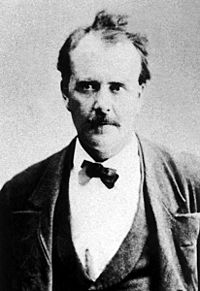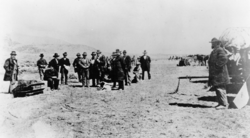Wells Spicer facts for kids
Quick facts for kids
Wells W. Spicer
|
|
|---|---|

Cropped from a group photo of John D. Lee's defense team in 1875
|
|
| Born | 1831 |
| Died | 1885 or 1887 possibly Ajo, Pima County, Arizona, Arizona
|
| Occupation | Justice of the Peace, journalist, prospector, lawyer, politician |
Wells W. Spicer (born 1831, disappeared 1885 or 1887) was an American journalist, prospector, politician, lawyer, and judge. He was involved in two big events in the American frontier: the Mountain Meadows massacre in Utah Territory in 1857, and the famous Gunfight at the O.K. Corral in Tombstone, Arizona Territory in 1881. After leaving Tombstone, he went back to looking for minerals. He disappeared sometime between 1885 and 1887.
Contents
Early Life and Career
Spicer was born in Chemung, New York. His parents, William and Seba Spicer, were farmers who followed the Presbyterian faith. He had an older brother, George, and a younger sister, Seba. When Wells was about nine, his family moved to Tipton, Iowa.
As a young man, Spicer worked for Samuel Augustus Bissell, a respected lawyer and judge. Under Bissell's guidance, Spicer became a lawyer in Iowa in 1853. That same year, Spicer and his friends started a newspaper called the Cedar County Advertiser. Spicer became the main publisher and editor the next year. He later sold his successful newspaper.
After trying and failing to become a county prosecutor as a Democrat in 1854, Spicer joined the Republican party. He then won the election to become a county judge in 1856. In July of that year, Spicer married Abbie Gilbert. They had a son, Earnest, a year later. Abbie and Wells separated in 1876.
Moving to Utah Territory
After a short time in Colorado, Spicer left his family in Iowa and moved to the Utah Territory in 1869 with his friend Charles Swetland. They settled in Corinne City. Spicer became a lawyer in Utah, focusing on cases about mining and land claims. He also opened a hotel.
Swetland died soon after, but Abbie and Earnest joined Spicer around that time. In 1871, the Spicers moved to Ophir City. There, Spicer continued his legal work, prospected for minerals, and started a tunneling company. He also kept writing for newspapers like the Salt Lake Daily Tribune.
When the silver mines in Ophir started to run out, the Spicers moved to Salt Lake City in 1872. In Salt Lake City, Spicer was appointed as a U.S. Commissioner by the Supreme Court. This meant he heard many legal cases, mostly in Bingham.
In 1874, Spicer leased an old lead mine called Rollins Mine, near Beaver. He found a valuable amount of lead and gold, which helped the area become busy again. Because of his connections in Beaver, Spicer became involved in a very serious event in Utah's history.
The Mountain Meadows Massacre Trial
In November 1874, a man named John D. Lee was arrested near Beaver. Lee was one of eight men wanted for a terrible event at Mountain Meadows. It's not clear how Spicer and Lee met, but Lee hired Spicer to be his lawyer, even though Lee first wanted to defend himself.
Spicer advised Lee to tell everything that happened, but Lee did not want to involve leaders of the LDS Church. Spicer put together a legal team to defend Lee. Lee's trial began in July 1875.
Spicer argued that other groups might have been responsible, or that the victims' actions angered the Native Americans. He also suggested that some people might have acted under orders from church leaders. Despite Spicer's efforts, no members of the LDS Church testified against Lee. The jury could not agree on a verdict, so it was a "hung jury." Eight jurors voted for Lee to be found not guilty, and four voted for him to be found guilty.
After this, Spicer was criticized by both sides. Non-Mormons thought he defended Lee too strongly, while Mormons were upset by his defense strategies. Newspapers often called him "One Spicer."
Lee was tried a second time in September 1876. This time, the jury was made up of members of the LDS Church who were expected to clear church leaders of any involvement. Even though the defense pointed out problems with the witnesses' stories, Lee was found guilty and sentenced to death.
Spicer and his team tried to appeal the decision, but the Supreme Court upheld it. Spicer asked the governor, George W. Emery, to pardon Lee, but the governor refused because Lee would not make a full public confession. Spicer was present when Lee was executed by a firing squad on March 22, 1877. The difficult trials made Spicer refer to himself as the "unkilled of Mountain Meadows."
Spicer continued as a U.S. Commissioner for Utah Territory until 1878. Feeling discouraged by these events, Spicer moved to southeastern Arizona Territory when he heard about a silver discovery in Tombstone.
Life in Tombstone, Arizona Territory
Spicer arrived in Tombstone by January 1880. He became a special writer for the Arizona Daily Star newspaper. Like in Utah, Spicer's articles were mostly about mining. He also continued to prospect for minerals and practice mining law.
A former friend, Charles G.W. French, became the Chief Justice of Arizona. French then appointed Spicer as a justice of the First District Court in June 1880. Spicer was also the first leader of King Solomon Masonic Lodge #5, a Masonic lodge founded in Tombstone in March 1881.
The O.K. Corral Hearing
After the famous gunfight on October 26, 1881, a special hearing was held. On November 1, Ike Clanton accused Wyatt, Virgil, and Morgan Earp, along with John H. "Doc" Holliday, of murder. Justice of the Peace Spicer led this hearing, which became known as the Spicer Hearing.
The hearing's goal was to decide if there was enough evidence to send the accused to a full trial. However, both the lawyers for the prosecution and the defense presented their cases as if it were a full trial. The defense lawyer, Tom Fitch, likely knew about Spicer's experience from the Mountain Meadows Massacre trial. He also knew Spicer was a Republican and might agree with the Earps' views against lawless groups.
Spicer was fair during the hearing, but he made two important decisions that helped the defense. First, he allowed Wyatt Earp to read a prepared statement without being questioned by the other side. The law was unclear about this, but Spicer ruled that Earp could make any statement he wanted, even if it was written beforehand.
Second, Spicer personally interviewed a witness named Addie Borland at her home after her testimony was confusing. He then called her back to the stand to answer his questions. This upset the prosecution. When she returned, she said she did not see any of the Cowboys raise their hands to surrender. This went against what other witnesses had said.
Spicer made his decision on November 30. He said that Virgil Earp's choice to involve his brothers and Doc Holliday was "unwise." However, he found no reason to charge them with a crime. Spicer gave a long explanation for his decision. In the end, the Earps and Holliday were free from a full trial. A grand jury later agreed with Spicer's decision and did not charge Holliday and the Earps.
Spicer again became a topic in newspapers. The Tombstone Nugget newspaper, which supported the Democrats, suggested that Spicer was not seen as completely fair. The Arizona Daily Star, where Spicer used to write, said he either didn't understand his job or was afraid to do it right.
Disappearance
Spicer went back to prospecting, first in Pima County, Arizona, and then in Ures, Sonora, Mexico. He invested all his money in a silver mine in the Quijotoa Mountains near Tucson. However, the silver veins were not deep enough to be profitable.
It is widely believed that Spicer, having lost all his money, walked into the Arizona desert in January 1887 and took his own life. Another historian reports that his body was found in Ajo, Arizona, in 1885.
Portrayals in Film and Television
- John Lawlor played him in Wyatt Earp (1994) imdb.com
- James Seay played him in The Life and Times of Wyatt Earp (Episode titled "Gunfight at the O.K. Corral", 1961) imdb.com
- William Schallert played Judge Herman Spicer in Hour of the Gun (1967) imdb.com


